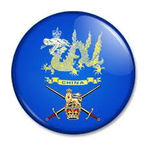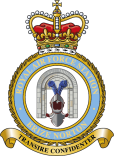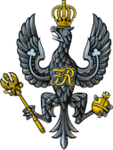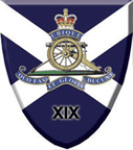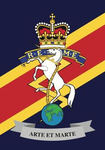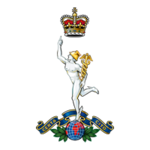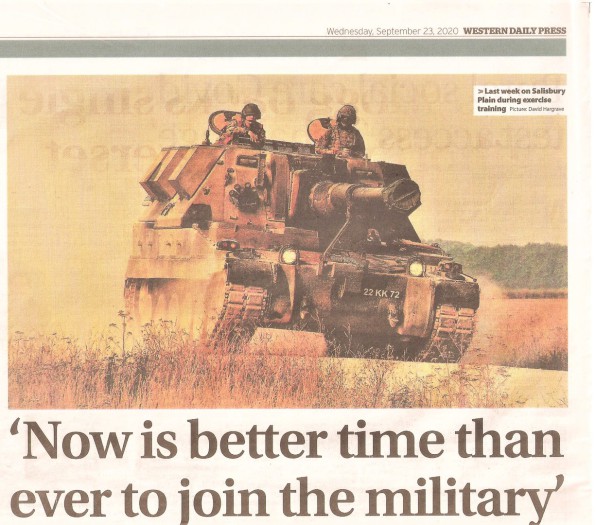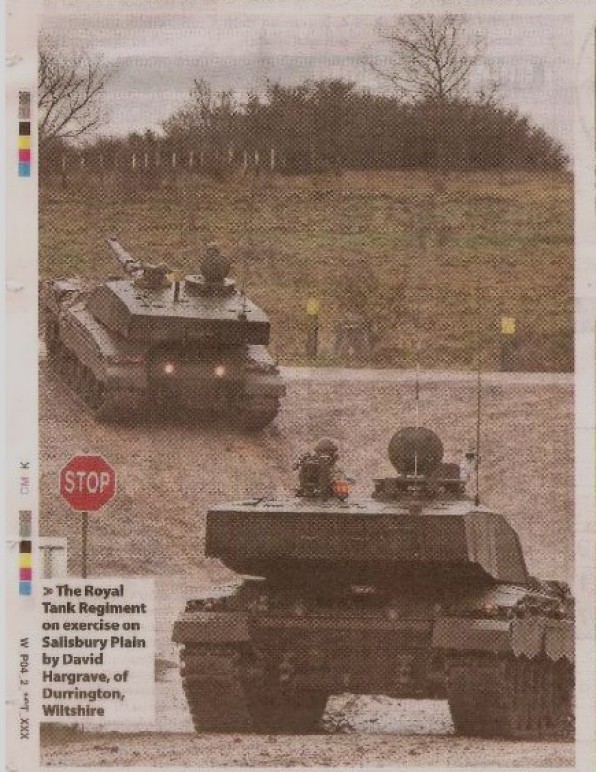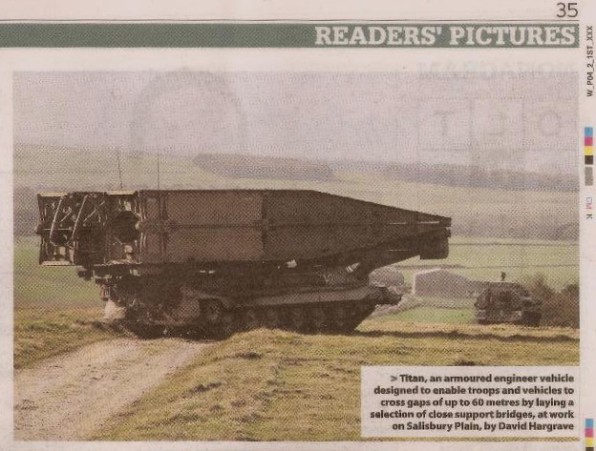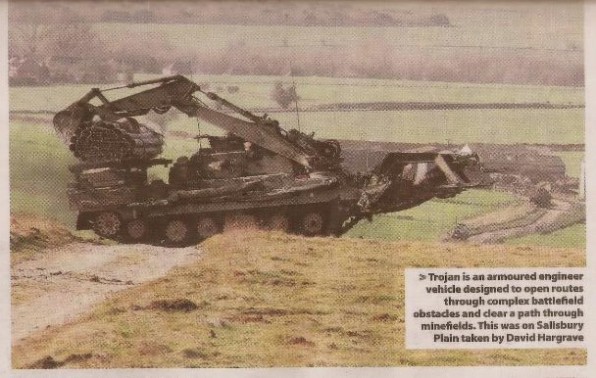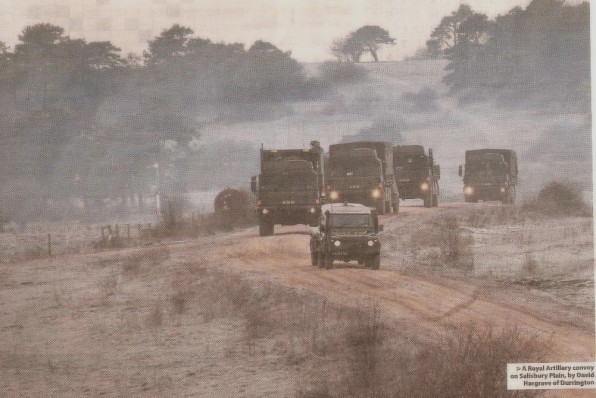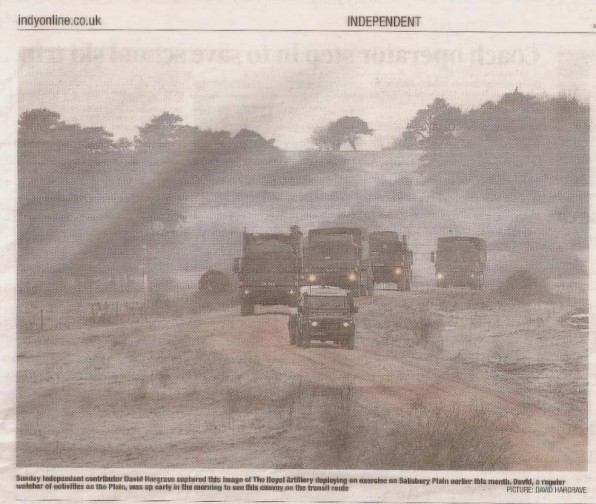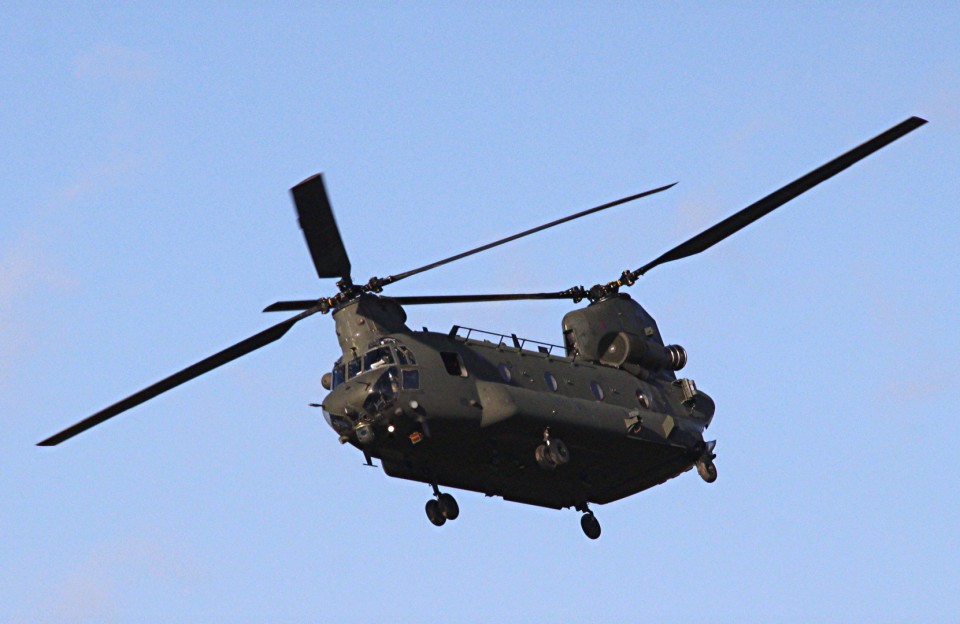
2020 Military on Salisbury Plain
The SPTA Newsletter is now available on line. I hope you find it useful.
www.gov.uk/government/publications/salisbury-plain-training-area-spta-newsletter
B Battery Royal Horse Artillery - 29.11.20
1st Artillery Brigade provides armoured artillery support to the 20th Armoured Infantry Brigade.
Batteries
The batteries are as follows:
Regimental Headquarters, at Assaye Barracks, Larkhill Garrison
· O Headquarters Battery (The Rocket Troop)
· A Battery (The Chestnut Troop)
A Battery Royal Horse Artillery is the senior Battery in the British Army's Royal Artillery and is part of 1st Regiment Royal Horse Artillery.
The Chestnut Troop is currently based in Assaye Barracks in Larkhill Camp.
The unit is currently equipped as a Close Support Artillery Battery, with the AS-90 Self-propelled gun.
· B Battery, equipped with AS-90
· E Battery, equipped with AS-90
B Battery, Royal Horse Artillery is a Close Support Battery of 1st Regiment Royal Horse Artillery. It is currently based in Purvis Lines in Larkhill Camp.
1st Regiment Royal Horse Artillery is a regiment of the Royal Horse Artillery in the British Army. It currently serves in the armoured field artillery role, and is equipped with the AS90 self-propelled gun. The regiment is currently based at Larkhill Garrison, Larkhill.
The Regiment completed its move from Assaye Barracks, Tidworth to Larkhill in June 2020
In 2014, B Battery re–rolled back to AS90 and in 2015 the Battery conducted Ex PRAIRIE STORM 3 in Canada in support of 1 Mercian. In 2016, for the first time, the Battery was tasked to carry out ceremonial duties in London at the Tower of London, Windsor Castle, Buckingham Palace and St James’ Palace.
B Battery deployed on Operation CABRIT 6 to Estonia as part of the NATO enhanced Forward Presence within the 1st Royal Regiment of Fusiliers (1RRF) Battle Group in March 2020.
The Battery assumed the role from E Battery who completed Op CABRIT 5.
The Battery later handed over to The Chestnut Troop in September 2020.
Along with three companies from 1RRF, the Battlegroup was composed of C Squadron Queen's Royal Hussars and Armadillo Company from the Danish Royal Life Guards who were later replaced by Vidar Company from the Danish Guard Hussars Regiment in July 2020.
The Battle Group’s task was to deter adversaries, defend Estonia if need be and to reassure the Estonian population.
The tour occurred during the COVID-19 pandemic which placed great restrictions on movements, exercises and resulted in the cancellation of Rest and Recuperation.
The major annual exercise for the regular and reservist components of the Estonian Army,
Ex SPRING STORM, was drastically scaled down to minimise the spread of coronavirus - this theme continued throughout the tour. B Battery conducted live firing in Estonia and Adazi, Latvia during June.
The relatively quiet deployment was certainly unique as the soldiers were understandably very concerned for their families back in the U.K. during the COVID-19 crisis.
RAF Atlas A400
The Airbus A400M Atlas is a European four-engine turboprop military transport aircraft. It was designed by Airbus Military (now Airbus Defence and Space) as a
tactical airlifter with strategic capabilities to replace older transport aircraft, such as the Transall C-160 and the Lockheed C-130 Hercules. The A400M is between the C-130 and the Boeing C-17 in
size; it can carry heavier loads than the C-130 and is able to use rough landing strips. Along with the transport role, the A400M can perform aerial refueling.
Mission Rehearsal Exercise
A major exercise deploys out onto the Plain. The photographs show part of one of the large logistics convoys to support 16 Bde.
16 Air Assault Brigade (16 Air Asslt Bde) is a formation of the British Army based in Colchester in the county of Essex. It is the Army's rapid response airborne
formation and is the only brigade in the British Army focused on delivering air assault operations. All personnel in the brigade wear the maroon beret, and those qualified as military parachutists
wear the appropriate Parachutist Badge.
The Second Battalion, Parachute Regiment (2 PARA), is a battalion-sized formation of the Parachute Regiment, part of the British Army, and subordinate unit within 16th
Air Assault Brigade.
2 PARA is an airborne light infantry unit capable of a wide range of operational tasks, based at Merville Barracks, Colchester Garrison, England. Personnel regularly
deploy outside the United Kingdom on operations and training.
The King's Royal Hussars
The KRH are a British heavy armoured regiment based in Tidworth, Wiltshire. Equipped with the awesome Challenger 2 Main Battle Tank and the Combat Vehicle Reconnaissance
(Tracked), we are also trained on a variety of other armoured vehicles.
Last week the Hussars deployed a battle group to the West of the Plain for a major Ten day exercise, The Battle group was headed by 17 Challenger 2 tanks.
19th Regiment Royal Artillery – The Scottish Gunners (until 2012 The Highland Gunners) - 26.10.20
19th Regiment Royal Artillery – The Scottish Gunners (until 2012 The Highland Gunners) – is a Scottish regiment of the Royal Artillery in the British Army. It
currently supports 12 Mechanised Brigade in the armoured field artillery role. The regiment has Fire Support Teams mounted in Warrior Mechanised Artillery Observation Vehicles equipped with MSTAR.
The regiment's three gun batteries are equipped with 24 AS-90 self-propelled guns.
Recovery 434 out on Exercise Supporting the Armoured Medical Unit - 13.10.20
The FV 434 is the Armoured Repair Vehicle variant of the British Army's FV430 series of armoured fighting vehicles. Introduced in the 1960s primarily as a means of
quickly changing Chieftain MBT power packs in the field, it is operated by the Royal Electrical and Mechanical Engineers. It is still used by the REME.
The FV 430 family of armoured vehicles entered service with the British Army in the 1960s, but regular maintenance and improvements including a new power train have
enabled this old workhorse to remain in service into the 21st Century.
FV 430 variants remain in service with the infantry, as command vehicles, 81mm mortar carriers, ambulances and recovery vehicles.
The FV432 can be converted for use in water, when it has a speed of 6km/h. Properly maintained, it is a rugged and reliable vehicle with a good cross country
performance.
1 Signal Regiment - 09.10.20
7th Armoured Brigade
Armoured Signallers
1 Signal Regiment provides critical communications support to 20 Armoured Infantry Brigade. Using the FV 432 Bulldog Armoured Vehicle, they can deploy the Brigade Commander’s Headquarters with secure communications anywhere on the battlefield.
The 7th Armoured Division had a red jerboa (a nocturnal rodent indigenous to North Africa) as its emblem and became known as "The Desert Rats".
The New Ajax Ares Reconnaissance Personnel Carrier - 02.10.20
The Household Cavalry Regiment, was the first regiment to receive the new, state-of-the-art Ajax reconnaissance vehicle.
The new Ajax strike and surveillance vehicle will be the most technologically advanced vehicle on the battlefield.
A British Army regiment has received several of the service's new armoured combat vehicles.
Arriving to the Household Cavalry Regiment at Bulford, Wiltshire, the Ares reconnaissance personnel carrier is part of the Ajax armoured vehicle family manufactured by
General Dynamics.
In February 2019, the Army was given two of the vehicles, to be used for training purposes.
The new Ares model borrows its title from the Greek god of war of the same name.
The M270 Multiple Launch Rocket System British Army Service - 02.10.20.
The British Army has two Regiments equipped with the MLRS, one Regular and one Territorial. The Regular Regiment operates 18 launcher vehicles and the TA regiment
12 in peace and 18 in war.
In 2007, Gunners & their MLRS’s from the 39th Regiment Royal Artillery (The Welsh Gunners) based in Newcastle, were deployed in the Helmand province of Southern
Afghanistan.
During theatre they have fired the new GMLRS XM30 rocket with its 200lb high explosive warhead, which has been developed by the UK, other European countries and the US.
It has a range of over 70km and earn’t the nickname ’70km Sniper’ because of its high accuracy thanks to the rockets on board GPS system.
1st Battalion, The Royal Welsh on Salisbury Plain - 30.09.20
On one of my trips across the Plain I came across this Battalion training. They state they are the best armoured Infantry Battalion in the British Army and I can
see why!
The Battalion is based in Tidworth and therefore, live locally with their Families.
Model map to show the object of the exercise
We watched the construction and presentation of this pre event training to their exercise tasks. It was amazing to see this simple task make real sense to those on
the ground.
Their vehicles and objectives were all labelled and amusing to see the enemy tank dumped off the area.
The model map was all removed and tidied up before they left.
Permissions to take all these photographs was received. I did say that no personnel in any of the photographs would be shown.
The Wolfhound - 27.09.20
The Wolfhound is a six-wheeled variant of the acclaimed Mastiff, which provides troops with increased protection as they support missions in high-threat areas.
This heavy-armoured truck is part of the Tactical Support Vehicles (TSV) group along with the Husky and the Coyote.
The TSV fleet is used to accompany front line patrols and carry essential combat supplies such as water and ammunition.
It provides a highly protected load-carrying vehicle to carry out a variety of tasks such as moving bulky stores for use in the construction of forward bases and also as
a gun tractor and gun limber for the Royal Artillery's 105 light gun.
Wolfhound is armed with a 7.62 GPMG self-defence weapon and the normal fit of radio and electronic equipment.
Helicopters used by the UK's Elite Special Forces on the Plain - 24.09.20
Two helicopters used by the UK’s elite special forces have been seen this week over Salisbury Plain.
Nicknamed ‘Blue Thunder’ the unmarked blue and white AS365N3 Dauphin helicopter, two of six the SAS has at its disposal.
The helicopters are flown by 658 Squadron of the Army Air Corps, and support 22nd Special Air Service (22 SAS).
Painted in civilian colours, the Dauphin helicopters – which are built by Airbus – have been seen transporting SAS forces to the scene of terror attacks in the United
Kingdom, most notably the London Bridge attack in June 2007.
They are quite a regular sight on the Plain during various exercises.
Military Quad Bikes (Small ATV) on Salisbury Plain - 23.09.20
Quad bikes (or small all-terrain vehicles) are in common service with a number of military forces to provide mobility and logistics support, generally dismounted forces,
light role infantry for example.
The operations start with SAS commanders studying hours of footage of potential target sites recorded by drones – Unmanned Aerial Vehicles (UAVs) – and listening to enemy
communication intercepts in a bid to identify IS leaders. Once the regiment’s senior officers have identified a target, the soldiers gather to receive their operational orders. They then leave their
secret base and climb aboard a fleet of helicopters – with the quad bikes already safely secured in the cargo hold.
As the SAS soldiers strap themselves into their seats, the pilots tap in the co-ordinates for the area of desert where the Chinook will land. As the helicopters’ engines
are so loud, the Chinooks take the SAS soldiers to a laying-up point as far as 50 miles from the target. The troops disembark aboard the quad bikes and prepare their general- purpose machine guns
(GPMGs) and Barrett sniper rifles.
Deployment of quad bikes will generally be via aircraft, inside a container or on a flat rack for sea transport, or on a truck or trailer for road transport.
Extract from www.thinkdefence.co.uk
Urbanised Challenger 2 Variant (Streetfighter II) - 22.09.20
This urbanised Challenger 2 variant, was developed by the Royal Tank Regiment to meet soldiers’ needs and identifies and fills the capability gap between the British
Army’s forces and adversaries in urban combat.
Supported by Army HQ, project Streetfighter II is aimed at adding modifications to the existing Challenger II Main Battle Tank (MBT) to improve lethality, situational
awareness and infantry-tank cooperation of ground forces.
The vehicle was recently trialled at the UK’s urban operations facility at Copehill Down Village on Salisbury Plain, where the Streetfighter was put through its paces in
an urban combat environment testing a range of upgrades from industry partners.
The project that began in 2018 and saw the upgrades showcased to a range of senior military figures and officials from the Defence Science Technology Laboratory
(Dstl).
Fuchs - 17.09.20
Great Britain (UK) – Designated the Fuchs NBC reconnaissance vehicle, the British Army owns 11 vehicles operated by the 1st Royal Tank Regiment as part of the UK Joint NBC Regiment. The Integrated Biological Detection System (IBDS) has recently replaced the Prototype Biological Detection System (PBDS) in service with the UK Joint NBC Regiment.
AS90 - 17.09.20
The AS90’s engine is a 660hp V8 diesel engine from Cummins, with a ZF Gears Ltd automatic transmission, with four forward and two reverse gears, giving it a top road
speed of 55km/h and an operational range of 370km.
The AS90 is lightly armoured with an all-welded 17mm thick steel armour construction. However there is currently in development, new armour to allow the AS-90 to
withstand anti-tank missiles and heavier rounds than its current protection against 7.62mm and 14.5mm armour piercing shells as well as 152mm shell fragments. It also has smoke dischargers and an NBC
system.
The AS90’s are fitted with a 155 mm gun (39 calibre Length) main gun, which fires NATO L15 155mm projectiles with a range of 24.7km using conventional ammunition. The
AS90 also fires Extended Range Ammunition rounds to 30km. It has a fire rate of 3 rounds in 10 seconds in burst fire, 6 rounds per minute for 3 minutes in intense firing and 2 rounds per minute for
60 minutes at sustained fire. It carries 48 rounds, 31 of these are stored in the turret bustle magazine.
The gun layer’s station is equipped with a Direct Fire Sight from Avimo (now part of Thales Optronics) for direct day and night firing. For indirect firing an Automatic
Gun Laying System (AGLS) with electronic elevation and traverse drives, provide laying to an accuracy of 1 mile and rapid target engagement. The Layer’s Display Unit (LDU) was designed by VSEL. The
commander’s station is equipped with a separate sight.
There is also a barrel cooling system to provide higher maximum firing rates in development. It also has a 7.62mm L7 GPMG mounted on thecommanders turret for close
protection.
The AS90 was upgraded with a Laser Inertial Artillery Pointing System, digital gun sight. The LINAPS provides the gunner with the position ofthe gun and the exact bearing
and elevation of the barrel. It includes the FIN3110 ring-laser gyro based, strap-down Inertial Navigation Unit with embedded military Global Positioning System.
Boeing CH-47 Chinook - 23.03.20
This photograph shows a Chinook on a training mission on Salisbury Plain.
During this training they often can be seen sat on a hillside with the tailgate lowered, as they would do in a hostile environment allowing the troops etc on
board to exit onto the hill without the helicopter landing.
The Chinook has an incredible carrying capacity of 33-55 troops or 26,000 pounds of cargo. The helicopter comes equipped with a triple hook system, allowing it to carry large internal or multiple external payloads.
The current CH-47F/MH-47G modernization programs will ensure this tandem rotor helicopter remains in the Army fleet through the 2030s.
Stormer - 17.03.20
The tracked Stormer vehicle provides a mobile platform for the Starstreak High Velocity Missile (HVM) system giving the detachment protection and excellent mobility with
eight ready to fire missiles and a further nine stowed inside.
The HVM system is a low-level Close Air Defence system with a rapid engagement capacity optimised to counter the attack helicopter threat. This highly flexible system is
also capable of being fired using the lightweight multiple launcher or from the shoulder. The missile employs a system of three dart type projectiles which can make multiple hits on the target. Each
of these darts has an explosive warhead.
The system is fitted with a roof-mounted air defence alerting device, providing target detection and prioritisation. A panoramic weapon sight is located at the front of
the vehicle.
The Starstreak High Velocity Missile (HVM) is designed to counter threats from very high performance, low-flying aircraft and fast 'pop up' strikes by helicopter
attacks.
The missile, which travels at more than three times the speed of sound, uses a system of three dart-like projectiles, allowing multiple hits on the target. HVM can be
fired from the shoulder, from a lightweight multiple launcher or from the Stormer armoured vehicle.
Foxhounds - 07.02.20.
The Foxhound is at the cutting edge of protected patrol vehicle technology and provides unprecedented levels of blast protection for its size and weight. These patrol
vehicles underwent final testing in the dusty and hot conditions of the Helmand desert before being deployed on operations.
Foxhound has been specifically designed and built in Britain to protect against the threats faced by troops in Afghanistan. However, this is an agile and versatile
vehicle that will be a mainstay in the Army for years to come.
Being lighter and smaller than other protected vehicles such as Mastiff and Ridgeback, Foxhound brings a whole new capability to the Army and is ideal for soldiers
operating in mentoring and partnering roles.
Foxhound has a top speed of 70 mph but can still protect against improvised explosive devices thanks to its v-shaped hull.
Titan - 05.02.20.
Titan is an armoured engineer vehicle designed to enable troops and vehicles to cross gaps of up to 60 metres by laying a selection of close support bridges. Along with
Trojan it gives a common heavy armour fleet based on the Challenger 2 Main Battle Tank chassis.
Titan can carry and lay the current range of in-service close support bridges, providing ground manoeuvre formations with improved capability, giving them greater
flexibility.
Improved visibility is achieved by incorporating direct and indirect vision systems including low light, image intensifying and thermal imaging capabilities. The
interior, and to some extent the exterior, of the vehicles
have been designed around the crew station positions.
Titan has the flexibility to support a wide range of operations, including humanitarian missions.
Trojan - 05.02.20.
Trojan is an armoured engineer vehicle designed to open routes through complex battlefield obstacles and clear a path through minefields.
Improved visibility is achieved by incorporating direct and indirect vision devices with low-light, image-intensifying and thermal imaging capabilities. The interior, and
to some extent the exterior, of the vehicle has been designed around the crew station positions.
Trojan has the flexibility to support a wide range of operations, including humanitarian missions.
Jackal 2 and The Coyote - 04.02.20
Jackal 2 is a high mobility weapons platform, with a unique air-bag suspension system allowing rapid movement across varying terrain.
It is designed to protect personnel against roadside explosions and mine attacks (the chassis is heavier than its predecessor to give additional protection). Jackal 2 is
armed with a General Purpose Machine Gun for crew protection and can carry either a Heavy Machine Gun or a Grenade Machine Gun as the main weapons system in the fire support role.
The gun ring has been moved forward to give a 360 degree sweep of fire. Jackal 2 is closely related to the new Coyote tactical support vehicle, which is a six-wheel,
Jackal-based armoured vehicle.
The Coyote tactical support vehicle, (TSV) light, is based on a 6x6 derivative of the Jackal 2 and supports the go-anywhere, high-mobility Jackals across harsh
terrain.
The extra two wheels gives a heavier vehicle, which can act in support of the Jackal 2 to transport supplies and equipment over similar terrain.
The Coyote, which has similar protection systems, armament and propulsion to the Jackal 2, can carry also an extra crew member compared to the original Jackal
vehicle.
Royal Engineers - 04.02.20.
These photographs show 22 Engineers and 26 Engineers.
The Royal Engineer BR-90 family is composed of bridges capable of Close and General Support and the associated wheeled support vehicles.
The bridges are built from interchangeable modular components. Originally designed for Load Class 70 tracked vehicles, the bridges may be crossed by vehicles of up to
Load Class 85 under strict safety conditions which accommodates the increase in Load Class of Challenger 2 variants. The bridges have two interconnecting track ways with a 4 meter overall bridge
width and 1 meter girder.
Giraffe - The Royal Artillery Deploys on Exercise
The Royal Artillery deploys on exercise this convoy, seen on the transit route.
Saab’s Giraffe AMB is a truck-mounted 3-D “agile multiple beam” surveillance radar that is housed in a single 6 m/ 20 ft ISO container with splinter and NBC protection,
mounted on a cross-country truck.
Its name comes from the Agile Multi-Beam (AMB) 3-D radar that sits on an extensible “neck,” in order to give it broader surveillance coverage with a range of 20-40 km/
12-24 miles.
The system takes about 10 minutes to set up and activate and 3 minutes for take-down. Setup can happen at leisure, after all, while take-down may involve enemy
aircraft who are moving into anti-radiation missile range.
Falcon Squadron - The Royal Tank Regiment - 22.01.20
I was out on the Plain today knowing there was going to be some vehicle movements, as vehicles returned to their home base. I did manage to see the vehicles when
they deployed in cold, crisp, sunny weather on Monday.
However, unlike the weather earlier this week, today was beset by thick fog with very little visibility, also unfortunately I was in the position of meeting these
vehicles on the Transit Route. Fortunately we were all travelling with lights on and it was on a part of the route that is quite wide and smooth.
With some hand waving etc we passed each other with no problems at all. I can imagine the poor visibility the personnel would have encountered, enclosed in these
machines.
Falcon Squadron - The Royal Tank Regiment
These vehicles from Falcon Squadron, The Royal Tank Regiment, in their operation exercise this week.
The unit of air tight armoured vehicles, designed to scout ahead of troops to find and identify potential chemical, biological or nuclear hazards on the
battlefield.
The squadron’s eight German-built Fuchs chemical, biological, radiological and nuclear (CBRN) reconnaissance vehicles use probes to take and analyse suspect samples with
a built-in mass spectrometer. Crew then feed back their discovery by secure link to scientists at the Ministry of Defence’s top secret Porton Down laboratories.
The vehicles, which are attached to 22 Engineer Regiment, are air tight and pressurised inside so that toxic chemicals cannot seep in. The four crew can stay inside
for up to six days if necessary, going to the lavatory in plastic bags.
This week on Salisbury Plain - 15.01.20
RAF Lakenheath in Suffolk, this week provided US military aircraft, including F-15 fighter jets based at the 48th Fighter Wing.
These aircraft could be heard several days this week providing air cover and performing ground attack trials.
Indeed it was only during a break in the low cloud and heavy rain that they were visible, this was mainly on Wednesday, still at considerable height in very strong
winds.
Lakenheath exercises such as we heard on Salisbury Plain this week, are crucial to provide both aircrew and support personnel stationed at RAF Lakenheath the
experience needed to maintain a ready force capable of ensuring the collective defence of the Nato alliance.
The airmen assigned to RAF Lakenheath are prepared to fly in the defence of our nation, the United Kingdom and our shared allies 24 hours a day, seven days a
week.
Training was conducted in accordance with Ministry of Defence and UK airspace regulations.
Other fixed wing aircraft taking part were NATO operated Boeing E-3A Airborne Warning & Control System (AWACS) aircraft, Beechcraft propeller communications
aircraft.
Non of these were seen but certainly heard for several hours during the daylight hours.
On Monday Osprey helicopters from Mildenhall were seen flying low by the village.
United States Air Force UK Osprey unit is based at RAF Mildenhall in Suffolk,
The rest of the week Wild Cat Helicopters and Chinooks were spotted carrying out landings etc out on the plain, but only seen on the Wednesday when there was a break in
the weather.


